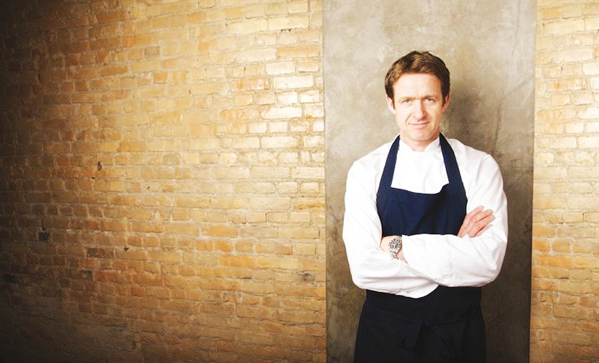Calgary’s “Sharper Chef” series is written by food and drink aficionados, and features prominent chefs, brewers, vintners and distillers who are willing to share some of their finest (and oftentimes secret) recipes. In this installment, executive chef Andrew Richardson of Blink shares his recipe for a locavore delicacy: braised Alberta rabbit with two mustards.
Ingredients
20 rabbit legs
200 g butter (clarified)
Ground pepper
Kosher salt
12 shallots, sliced
500 ml white wine vinegar
1.5L white wine
6 tbsp Dijon mustard
6 tbsp grained Dijon mustard
3L chicken stock
750 ml heavy cream
4 sprigs of thyme
12 cloves garlic (crushed)
2 bay leaves
The Plumper Thumper
“When you’re cooking rabbit, for the most part, it’s better to try and find something that’s farm-raised and organic, if you can,” says Richardson. “Wild rabbit is usually not as good because it’s going to be tougher and have a more wiry texture.” Blink uses two suppliers for all its rabbit needs, with the majority coming from Lethbridge’s J&M Rabbit Farms. “The leg meat should have a nice shine to it, with the flesh pinkish in colour — a similar colour to fresh pork — and it should be odour-free.” The recipe featured here makes a large amount: Two rabbit legs is a good-size portion, so grab some friends or prepare for leftovers.
Let’s Be Clear Here
While teaching his techniques at Blink’s monthly cooking classes, Richardson often stresses the importance of using clarified butter when making many dishes; rabbit is no exception. “It doesn’t burn and can withstand high temperatures,” he says. “When you’re using it for searing rabbit legs, it’ll give you that nice, delicate golden colour on the outside without burning.”
The Same Sizzle
Season the legs with fresh ground pepper and kosher salt, and place them in a heavy-bottomed pan, coated in clarified butter. Sear the legs on all sides until they are golden brown and remove them from the pan. (Place them to the side — you won’t be needing them for a bit.)
It’s important to use the pan in which you cooked the rabbit, Richardson emphasizes, when you add the finely sliced shallots (your next step) and begin creating the casserole sauce. “Always use the same pan, because when you sear the rabbit legs you get that lovely meaty residue in the bottom of the pan. When you add the shallots, you’re adding to that flavour — you’re getting more and more flavours in the dish.” Sweat the shallots until they are soft.
Place the vinegar in a casserole dish and cook on high until it is reduced by ⅔, repeat the process one more time with the white wine (until it is again reduced by ⅔). Add to the casserole all remaining ingredients — minus the grained mustard, which you’ll use to finish the sauce — and cook on high in the oven, bringing it to a boil.
Place the rabbit back in the boiling sauce, cover and cook at a low temperature.
The Finish Line
By now, your bunny is simmering in delicious sauce and you’ve entered the final leg of the race. Be sure to check on the rabbit often by pinching the thigh and leg bone together, as if the hare was running one final lap. “Squeeze the leg like it was moving,” says Richardson. “If the meat is starting to pop off the bone when you bend it, it’s a good sign that it’s cooked.”
When the rabbit is cooked, remove it from the casserole. Strain the braising liquid through a fine sieve into a pot, and cook until reduced to the consistency of a heavy cream. “The more sediment you can remove in sauces, or the cleaner you can make the sauce, the better it’s going to be,” Richardson says. Whisk the grained Dijon mustard into the sauce. When ready, warm the sauce and spoon it onto the individual rabbit legs, then place the legs back in the oven for approx. 10 minutes, until they’re warm.
Blink serves the dish with some ribbon pasta and seasonal mushrooms. As for wines, Richardson offers,“We find that it goes very well with a Pinot Noir.”
——————–
Image courtesy of Blink Restaurant.


